This was published 3 years ago
‘I ain’t no Bambi’: How a paediatrician ended up in politics
When Monique Ryan defeated treasurer Josh Frydenberg to become the federal member for Kooyong, she shocked the political class – but not those who knew her well.
By Melissa Fyfe
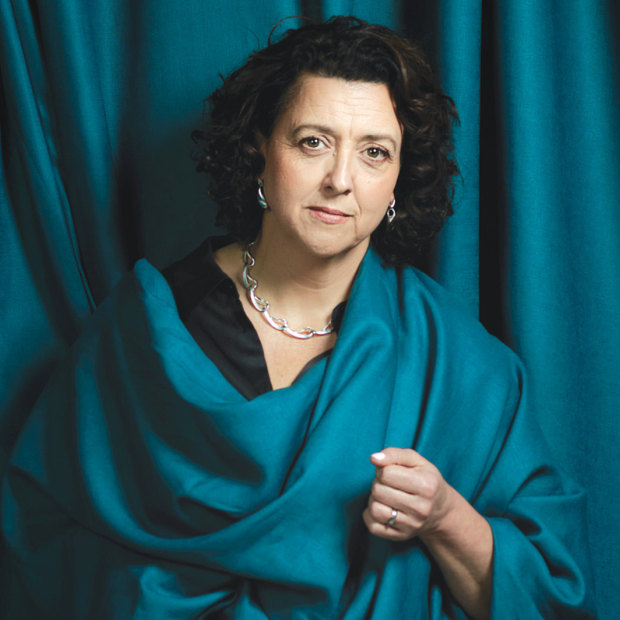
Monique Ryan suffered a “vapours” attack shortly after she decided to run as an independent for Kooyong. “I suddenly thought, ‘If they don’t pick me, I’ll be gutted.’ And that was the way I realised that I had to do it.”Credit: Kristoffer Paulsen
As you might expect, there’s a fair bit of teal on Monique Ryan’s desk: a cowboy hat, a porcelain dove and a little figurine of a deer, all gifts from supporters. Nearby, on her office table, sits a bit of light reading: economist Ross Garnaut’s Superpower, a road map to Australia’s low-carbon future. And on the wall is a print by The Age artist Jim Pavlidis called Kicking Yips – After Pollock, in which an AFL goal umpire flags a point after a failed goal attempt. The yips describe an athlete’s sudden loss of skill in a pivotal moment, making this an odd choice of artwork because if there’s one thing Ryan has rarely experienced in life, it’s the yips.
But late last year she did have “a massive attack of the vapours”. This condition, distinct from the yips but on the same emotional trajectory, struck shortly after she applied to run as an independent for Kooyong, the well-to-do federal electorate in Melbourne’s eastern suburbs, in the 2022 federal election. It looked like the selection committee, a group of local residents, might actually choose her and suddenly, crushingly, the enormity of this arguably bonkers decision hit home.
Here she was, at 54, a top medical researcher, paediatric neurologist and professor at two universities, a sensible woman of science whose life work has been saving dying babies, seriously considering quitting to take down federal treasurer Josh Frydenberg, one of Australia’s most well-connected and powerful politicians, someone whom everyone believed, not least himself, would one day be prime minister.
During the “vapours” attack, she called some friends and said: “Oh, my god, I don’t know what to do, I think they’re gonna pick me. And I need help. Because what if they pick me? I’m going to have to leave my job.” She also confessed to her husband, Rhinomed executive Peter Jordan, that she was likely to be chosen. “Of course they’ll pick you,” said Jordan, because he, like everyone close to Ryan, knew she generally gets what she goes after. “Then I suddenly thought, ‘If they don’t pick me, I’ll be gutted.’ And that was the way I realised that I had to do it.”
Ryan is telling me this in her campaign office, a chilly former bank building in Glenferrie Road, Hawthorn, nine days after she confounded political pundits by capturing 40 per cent of Kooyong’s primary vote. (“A staggering mobilisation in one election,” says Monash University politics professor Paul Strangio.) Now, just down the road in Hawthorn East, Frydenberg is packing up his electorate office and Ryan is waiting to move in as the new MP for Kooyong, famously the seat of Liberal Party founder Robert Menzies.
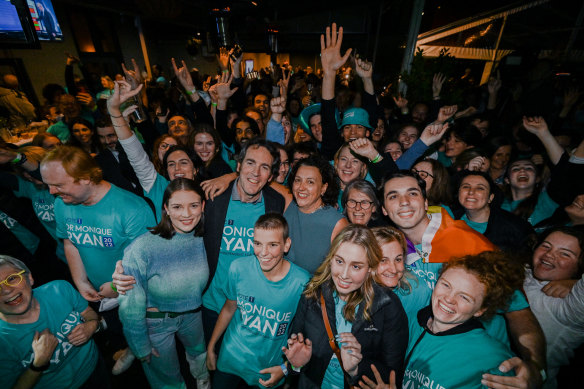
A victorious Ryan on election night, flanked by her husband Peter, stepdaughter Annabel (left) and son Patrick (front). Credit: Joe Armao
“You can probably hear the sound of shredding from here,” she jokes from her desk chair, wearing an appropriately Melbourne-in-late-autumn outfit of black R. M. Williams boots, black jeans and a black-and-white chevron-print suit jacket. Her glasses are perched atop her “unelectable hair”, as one early campaign adviser referred to her wayward dark curls. Ryan ponders whether Frydenberg will leave any handover materials. “I think I’ll be lucky to get more than a packet of prawns in the air-conditioning vent,” she deadpans with her low-pitched voice.
This is when I realise one of the many surprising things about Ryan: she’s naughtily funny, something probably not evident in her serious, furrowed-brow media appearances. A few years ago she even did stand-up at the Melbourne Comedy Festival in a niche category showcasing scientists. (One of three times she’d been so scared her legs shook. The other two: marrying Jordan and her campaign launch.)
As Ryan waits to move into Frydenberg’s electorate office, the nation is coming to terms with a new political landscape. A teal wave of grassroots optimism and hope – for a new type of politics, for a different type of politician – swept the independents to victory. Now they must deliver. How will Ryan and the other five new teals, plus the broader crossbench, organise themselves? If at all? Who might emerge as a leader figure? Without the balance of power in the lower house, how will they achieve for their electorates what they campaigned for? And will they in fact change politics for the better, as they so keenly desire?
When they go to Canberra next week for the new parliament, what sort of politicians will these non-politicians be?
It was harder for Frydenberg to malign a doctor who has spent years looking after children with life-shortening and often fatal muscle and nerve diseases.
In December last year, an unnamed political observer said in The Age that attacking a children’s doctor like Ryan would be “like taking on Bambi” (hence the deer figurine on her desk). It’s certainly true that it was harder for Frydenberg to malign a doctor who has spent years looking after children with life-shortening and often fatal muscle and nerve diseases. But actually, in person, Ryan is nothing like Bambi.
“The people I worked with would have been rolling around the floor laughing at me being called Bambi,” she says. “I ain’t no Bambi.” She ain’t no puppet, either, which is how many, including Frydenberg, cast her: a puppet specifically of Simon Holmes à Court, Kooyong resident and convenor of Climate 200, the crowdfunding vehicle that boosted the teal campaigns. (At times during the campaign, Ryan, who thinks Holmes à Court is “a really good person”, asked him to “cool it” when he got into skirmishes with Liberals. “I said, ‘It’s my campaign and I don’t want you to f… it up.’ ” )
Ryan has all the qualities that make the kids’ doctor from central casting: empathy, kindness, compassion. And dealing with the life and death of babies has given her an unflappable disposition. But she is also brutally and refreshingly honest, fiercely competitive and does not suffer fools. Four days before we meet, Ryan appeared on ABC TV’s Q+A. She sat next to Liberal senator Andrew Bragg, who told a childcare worker in the audience that 20 or 30 years ago her profession was considered “a bit of a hobby”.
Facing up against Labor’s spokesperson on childcare, Amanda Rishworth, Ryan thought Bragg’s responses undercooked. “I look at these sorts of people and maybe it’s an arrogance thing, but I think, ‘You’re not that smart. Shouldn’t you have been prepared for this?’ ” she says.
At the end of our interview, Ryan gives me a tour of the campaign office. I meet her campaign manager, retired political scientist Ann Capling, 63. Before Kooyong, Capling had never run a campaign but had written five books on the international political economy and the multilateral trade system. I also meet Ryan’s diary organiser and community co-ordinator, Julia Cutts, 40. She’s on a break from her job at the Burnet Institute, where she’s an expert on malaria elimination in the Asia-Pacific. Ryan pauses to contemplate the imminent move into Frydenberg’s electorate office. “We’re going to have to have a smoking ceremony. And probably an exorcism,” she muses. “And then a really big party.”
As a teenager, Peter Ryan hated his younger sister Monique. She hated him, too. The second and third eldest of seven kids to parents Maurice and Marguerite, the pair were locked in relentless competition over pretty much everything. “It was not so much a fear of losing. It was a hatred of losing,” says Peter, chief legal officer of Monash Health, Victoria’s largest public hospital network. He was dux at his Catholic boys’ school St Kevin’s College and got 398 out of a possible 410 on his Higher School Certificate. The following year, Ryan was made dux of her girls’ school, Loreto Mandeville Hall in Toorak, with a score of 406. “She was the kind of person who would literally study all night then come along the next day and set the record for 100 metres at the school swimming carnival. I’ve never known her to fail at anything.”
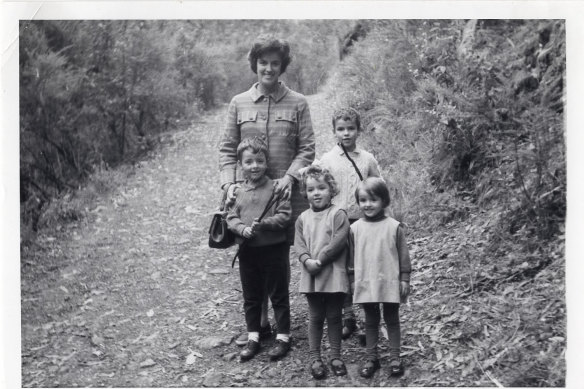
Ryan (centre) circa 1970, aged 3, with mother Marguerite, brothers Peter, 5, and Alan, 7, and twin sister Anny.Credit: Courtesy of Monique Ryan
One night, Peter set up a contest Ryan had no idea she was competing in. As she studied into the night, he tried to stay up later, waiting until the wee hours until finally her light went out. Triumphant, he went to bed. “I got up about half an hour later and her light was back on. She’d gone to bed and recalled something she needed to write down. At that stage I knew I was just totally defeated.”
The Ryan family lived in Caulfield North, Toorak and Hawthorn, suburbs in and around the Kooyong electorate. Maurice Ryan was a telecommunications sales manager, while his wife Marguerite, at first a housewife, went on to be a professional fundraiser. After visiting Africa she set up a successful charity, Women for Women in Africa, supporting the people of the Kibera slum in Kenya. “She’s just quite an extraordinary woman, actually,” says Ryan.
Maurice lost his job in his early 50s, and struggled to get work long-term after that. Says Peter: “The economic impacts of the 1980s were very heavy on a generation of families, and that impacted both Monique and I. That experience [watching their father struggle to secure permanent work] drove us to some degree.”
Ryan also has a twin sister. Her name is Anny Murray and she is nothing like Ryan in temperament, looks and life choices (more on that later). But they are best friends. Coming home from school Murray would chat up boys on the tram, while Ryan – disciplined, academic – could walk all the way home without lifting her head from a book. “I can’t remember ever thinking she’d go into politics, but I always knew she’d excel at whatever she did,” says Murray.
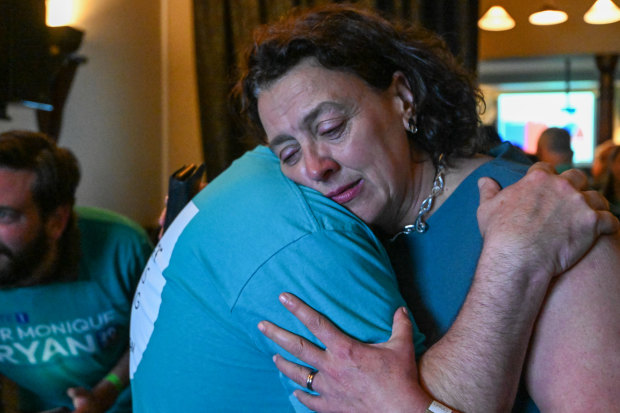
Ryan embracing her brother Peter on election night, remembering Peter’s son Hector, who died in 2017, hours after his VCE exams. Ryan was the first to their house at 3am that night and took Peter and his wife Cate to the Coroner’s Court to identify Hector’s body.Credit: Joe Armao
Growing up with six siblings gives you “hard-won robustness”, says Ryan. “We’re pretty hard on each other, but then if anyone else has a go at one of us, we’ll fight that person to the death.” This happened during a heated moment in the campaign, when Ryan’s eldest brother, Alan Ryan, a defence expert based in the United Arab Emirates, described Frydenberg in a tweet as a “#poisonousshit” and “grubby little man”. Ryan quickly distanced herself from the comments. “I tore him [Alan] a new one,” she says. “He was, like, ‘But he had a go at you!’ ”
As Peter and Monique grew older, they stopped fighting and became extremely close. There’s a picture taken by The Age on election night of the two embracing, Ryan’s head resting heavily on her brother’s shoulder. They’re sharing a moment thinking about Hector, Peter’s 18-year-old son who died in a car crash in 2017, hours after finishing his VCE exams. The night Hector died, Ryan was the first person at Peter’s house at 3am to console him. She later took him and his wife Cate to the Coroner’s Court to identify his body.
“She just put everything down and was there from the word go, which is her selflessness to a T,” says Peter. “So my debt to her is everlasting.”
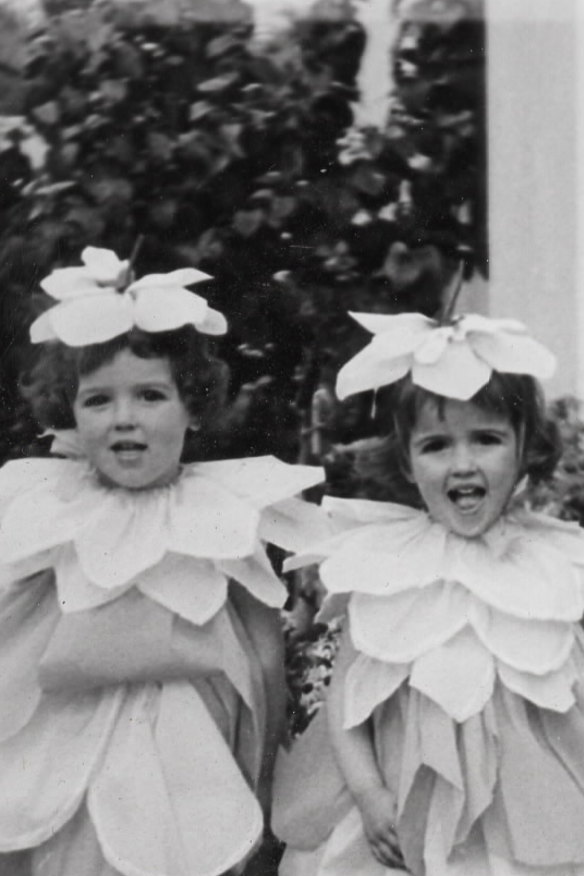
Ryan (left) taking part in a dress-up competition with twin sister Anny. Credit: Courtesy of Monique Ryan
One November night last year, after a hard day at the Royal Children’s Hospital, Monique Ryan walked into Hawthorn restaurant Osteria 20 for an unusual job interview. “She actually looked like a cat dragged backwards through a hedge. It was hilarious,” says Ann Capling, who wears canary-yellow framed glasses and is almost pocket-sized. (“She kind of levitates when she’s excited,” says Ryan.) The Canadian-born Capling, a former deputy vice chancellor and provost at Perth’s Murdoch University, was the true engine of Kooyong’s independent movement.
She and about 30 other progressive-minded Kooyong residents had formed Voices of Kooyong, based on the Voices for Indi movement that powered independent Cathy McGowan’s takeover of that Victorian Liberal-held seat in 2013. In September 2021, former Labor staffer and pollster Kos Samaras told the group’s steering committee that he thought Kooyong winnable due to its changing demographics, with more young, educated professionals moving in and growing concern about climate change.
Inspired, Capling asked former renewable energy executive Oliver Yates if she could use Kooyong Independents, the corporate entity he’d kept going since unsuccessfully running against Frydenberg in 2019. It had a database of 600 people and the NationBuilder campaign software, which provides a website and facilitates donations. Yates agreed and in October 2021 Kooyong Independents set about raising money for full-page advertisements in The Age and The Australian Financial Review headlined: ARE YOU THE NEXT MEMBER FOR KOOYONG?
Around the same time, writer Anna Sublet, one of Ryan’s dearest friends, saw a tweet about the ads and texted it to Ryan. When I ask Sublet why she thought Ryan would be interested in running as the Kooyong independent, she recalls a night at a bar a few years earlier when Ryan revealed a desire to move into federal politics. “All of us thought [back then] that would be great – Mon’s trip to Canberra! We’re all coming! … It was a bit of a laugh, but we knew that she was genuinely thinking how she could contribute.” It took only four minutes from Sublet’s original text before Ryan replied with: “Ok if you insist.”
But enormous life decisions aren’t born in minutes. A year before Sublet’s text, Ryan and her son, Patrick, then 12 years old, were watching A Life on Our Planet, David Attenborough’s “witness statement” about how humans and climate change were impacting the natural world. Patrick became upset. “I could just see him thinking, ‘Well, why don’t you people sort this out?’ ”
She agreed. She felt Australia could make an intelligent shift to renewables, with an economic upside. She was appalled at the $12 billion worth of fossil-fuel subsidies and the sway the industry seemed to have in Canberra. “I just thought, ‘Why aren’t these stupid people taking action on it?’ ” Her voice is thick with contempt.
When she confessed her plan to the Royal Children’s Hospital, they asked her not to do it. “They thought it was disruptive and I think some thought it was a vanity project.”
Bubbling alongside this was Ryan’s ongoing frustration with Australia’s health policy: government blame-shifting, the mishandling of COVID-19 and a lack of transparency in medical research funding. For two years, she’d unsuccessfully lobbied then health minister Greg Hunt to establish newborn screening for spinal muscular atrophy. Research had shown that if the condition was identified and treated at birth, about 80 babies a year would be able to live fuller lives; the health budget would also benefit.
In the end, she says, it came down to, “Someone needs to do this, I could do it, so I should do it.” When she confessed her plan to the Royal Children’s Hospital – where she was chief of the neurology department – they asked her not to do it. “They thought it was disruptive and I think some thought it was a vanity project, a complete waste of time.”
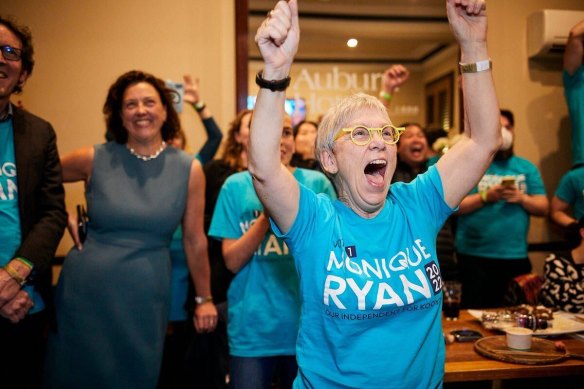
Ryan’s campaign manager, retired political scientist Ann Capling, on election night.
In mid-November, at the Osteria 20 restaurant, Ryan met selection committee members Capling, Carolyn Ingvarson, founder of the influential local climate action group Lighter Footprints, and Simon Holmes à Court. (Holmes à Court, whose Climate 200 raised $13 million from 11,200 donors for the 23 teal candidates at this year’s federal election, is on record saying he wasn’t involved in the preselections – but he was at the meeting as a politically active resident of Kooyong, he says, not as the convenor of Climate 200.)
“We’d all looked at Monique’s application and we thought she was politically very inexperienced, but she just gave us a little shiver,” says Capling, who helped assess all 30 candidates for Kooyong. Ryan sat down and confessed she couldn’t believe she was having the discussion. “Then she looked at us and said, ‘Of course, if I was selected as the candidate I would have to zhuzh myself up a bit,’ ” says Capling. “She presented as a busy professional who was putting her job first, but she had enough self-awareness that if she was going to run for office, she’d have to, like, do her hair.”
Impressed, they asked her to talk with several people, including Cathy McGowan, and to write a one-pager for them on how to win the election. “I’ve got no idea,” was Ryan’s immediate thought.
When Monique Ryan finished high school, her head was not filled with romantic notions of healing the sick. History was her great love. “I would have happily been a historian or a journalist,” she says. “I wanted to be the next [Canberra press gallery veteran] Michelle Grattan when I was 16 and 17.” In the end, she chose a double degree in medicine and arts at the University of Melbourne, partly because she had the marks to get in (finding herself overloaded, she dropped arts pretty quickly).
Ryan actually disliked studying medicine and hated student hospital placements because “you feel like a bump on a log half the time.” In 1990, after her fifth year, she backpacked around Europe and decided to switch to law (her brothers, who had law degrees, advised that medicine and law would make her particularly attractive to law firms). To fund her law degree, she decided to finish her medical training, interning in emergency at Melbourne’s Austin Hospital. She loved it. “When you’re the person who’s responsible, it’s
actually really fun,” she says. “And, in the emergency department, when a child would come in everyone was scared of them. And their parents were scarier. But I would just gravitate towards them.”
Dumping the law plan and choosing paediatrics, she did her first year of specialist training at the Royal Children’s Hospital in 1993. But in her first real taste of failure – if you discount her 1990 loss on Sale of the Century, which only yielded her a skateboard and a cot (she came second, she says) – Ryan was not picked to continue for a second year. She puts this down to too much fun seeing bands every night (Dave Graney, Ed Kuepper, Hoodoo Gurus). Luckily, Sydney’s then-named Prince of Wales Children’s Hospital offered her a placement. “I didn’t want to go. I didn’t know a soul [in Sydney]. I felt like I’d failed.”
Several years later, when Ryan was studying for her paediatric exams, a junior consultant neurologist called Kathryn North gave a lecture about muscle diseases. Ryan approached her afterwards and said: “I want your job.” North laughed and told Ryan to contact her once she’d passed the notoriously difficult exams. North, now director of the Murdoch Children’s Research Institute, became Ryan’s mentor and helped her secure a neurology training position at Sydney’s Westmead and then, in 1999, a position at Boston Children’s Hospital, home to the world’s best paediatric neurology department. Soon she was publishing papers in respected journals and presenting them around the world.
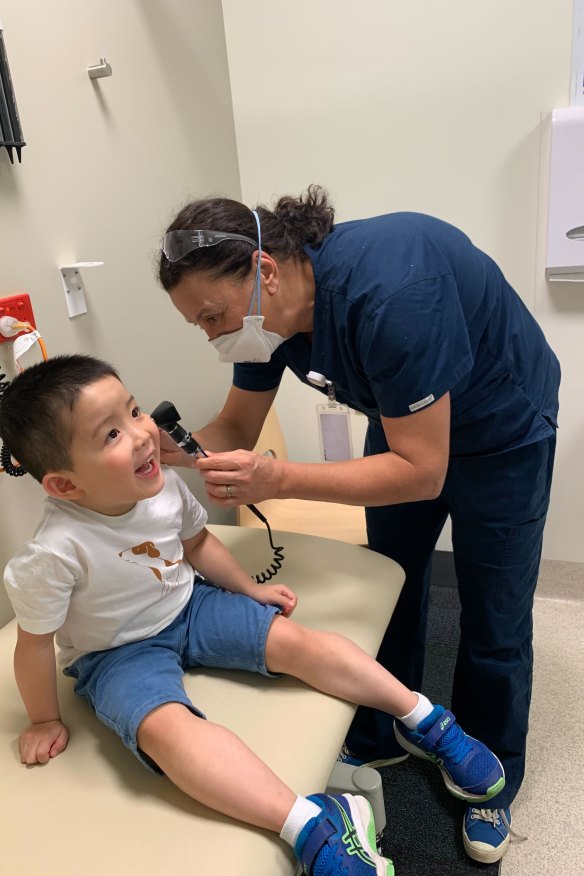
After 15 years, Ryan’s final clinic at the Royal Children’s Hospital.Credit: Courtesy of Monique Ryan
Ryan specialised in two main muscle and nerve diseases in children: Duchenne muscular dystrophy, mostly affecting boys, and spinal muscular atrophy (SMA). When Ryan first began to specialise, Duchenne sufferers were diagnosed at around five years old and dead by their early 20s. Spinal muscular atrophy babies died before they were two.
“When I started doing this, almost everyone died,” she says. It was a tough field in the 1990s, and only doctors who felt able to cope with high patient death rates would have chosen it. But while Ryan found the work difficult, it was also rewarding; a privilege, she says. “If you know a child is going to die, it’s so important to look after them and the parents and all the staff around them, to be kind and caring. But also to be decisive. The parents remember how this is managed for the rest of their lives, so it is a great responsibility to do it properly.”
Just after Ryan returned in 2003 to Sydney as a consulting neurologist at the Children’s Hospital at Westmead, American researchers began to develop genetic and gene therapies for SMA, which afflicts one in 6000 babies. Over the next 15 years, Ryan became heavily involved in running clinical trials for the therapies in Melbourne and Sydney. Today no one knows how long the SMA babies will live for, but they haven’t lost one yet. And they can walk.
“Just to be a part of that, it was extraordinary,” she says. “It’s a hard thing to walk away from, actually.” (She cried on her last hospital day and still does when she thinks about leaving.) Senior neurologist Andrew Kornberg, who recruited Ryan back to Melbourne’s Royal Children’s Hospital in 2006, says: “One of the best things I did as department head was getting Monique down here. She’s a go-getter, a great researcher, a great doctor and a caring professional.”
“I didn’t think I was ever going to find a life partner and I didn’t want to be childless as well.”
When Kornberg did lure Ryan back to Melbourne, it was a heartbreaking decision. She had a close friend in Sydney dying of cancer. “I did feel like I was abandoning her,” says Ryan, suddenly in tears. But she was also 39, single and childless. She’d had phone calls with her sister Anny Murray – a stay-at-home mother with seven children – in which she confessed to wanting a family like her (perhaps with fewer babies) and Murray said she wanted to be free and travel like Ryan.
“For a long time I was single and sometimes lonely. There was no one there when I came home,” says Ryan, of her life up to that point. And now, tick-tock, the fertility clock was running down. Ryan resolved to return to Melbourne and have a baby on her own. “I didn’t think I was ever going to find a life partner and I didn’t want to be childless as well,” she says. “I thought, ‘If I’m going to have a baby by myself, I need to be around my family.’ ”
But first, back in Melbourne, she threw a huge party with Anny for their 40ths and invited all the people she hadn’t seen for 10 years, including a man she’d worked with during university at the Arts Centre. “I’d always thought he was a special man. He was this bloke who I’d had this thing for my whole adult life, who I’d gone out with for about 10 minutes when we were about 20 or 21.” This was Peter Jordan, and they’d had a few sliding-doors-bad-timing issues. Now a single father-of-two, he turned up at the party. A week later they had dinner.
“It was pretty kind of instant from that point,” Jordan tells me on the phone. Six months later, Ryan was pregnant and within two years she was married with a baby and two stepchildren under eight. “That took a bit of adjustment,” she says with characteristic wry understatement.
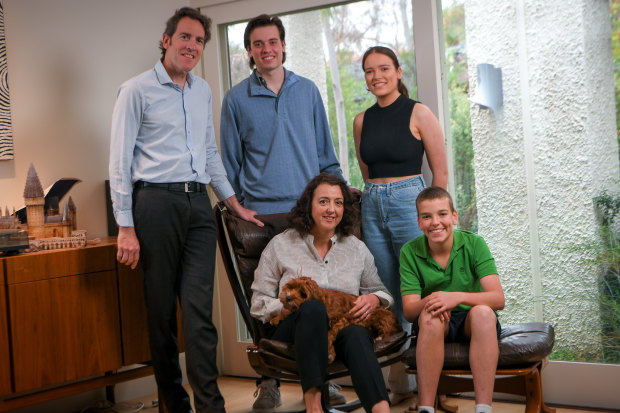
Ryan with husband Peter Jordan, stepchildren Campbell and Annabel, son Patrick and cavoodle Alfie.Credit: Eddie Jim
The pair love AFL and barrack for Carlton. They even like the same music, but he draws the line at Ryan’s love of the Smiths and Morrissey. Jordan says there’s an equalness to their relationship and that it’s easy. “I love her confidence, her intelligence,” he says. Both mention it isn’t easy blending a family. “Step-parenting is one of the hardest things I’ve done,” says Ryan, who describes Annabel, 21, and Campbell, 19, as “lovely, lovely kids”. “I’ve been very fortunate that Annabel and Campbell have always been really generous and accepting of me, and we’ve all managed to build a very loving, accepting family.”
On an afternoon in early June, Monique Ryan’s 10-year-old VW Golf is parked outside their Hawthorn home in a quiet street not far from her campaign office. Next to the Golf is Jordan’s 17-year-old Subaru wagon, bearing a Mon4Kooyong sticker. The “Gooms”, a term Ryan and team gave the Grumpy Obnoxious Old Men who would scowl or lecture her during the campaign (with their wives often winking at Ryan supportively behind their backs), regularly ask her why she doesn’t drive an electric vehicle if she cares so much about climate change. “I tell them I can’t afford one, but I’d love one,” says Ryan. “Then I say, ‘Can you afford one?’ And they say, ‘No.’ And I say, ‘Exactly! That’s what I’m talking about. We need to make them more affordable.’ ”
Ryan answers the door and shows me past the original 1930s-style entrance, book-lined and dark, to the renovated, light-filled back, with its long kitchen bench, a wall of green cupboards and a calming view of a solid eucalypt trunk in the backyard. Alfie the cavoodle, a pandemic puppy, starts chewing my boot. “He’s a behaviourally challenged dog,” she says, apologetically. Ryan is just back from a quick trip to Canberra where, thrillingly, she visited Parliament House’s members-only area. “I was like a kid on a school excursion!” In her handbag on the bench is her current reading: Cathy Goes to Canberra, McGowan’s manifesto on getting elected and surviving politics. A guidebook of sorts.
“Do you mind if I just chop up my chicken?” she asks. She’s preparing a curry in the slow cooker while telling me about the first time she met Josh Frydenberg, an experience she found awkward, tense and stressful. It was at the Australian Electoral Commission’s bingo-like draw that determines the order of names on the ballot paper. The stakes were high: in a tight contest like Kooyong, the number one spot can be the difference between winning and losing. Ryan describes Frydenberg turning up with his entourage.
“He comes in and basically takes over the room. And he says, ‘Monique! We meet at last.’ ” Ryan, ever competitive, clocked that she was taller than him. “I thought, ‘That’s gotta be a win!’ ” After a long process, Ryan’s ball got top position. Frydenberg drew number seven. She watched the then treasurer, just in front of her, clenching his fists and turning redder as the ballot drew on. “Then they all just wheeled out.”
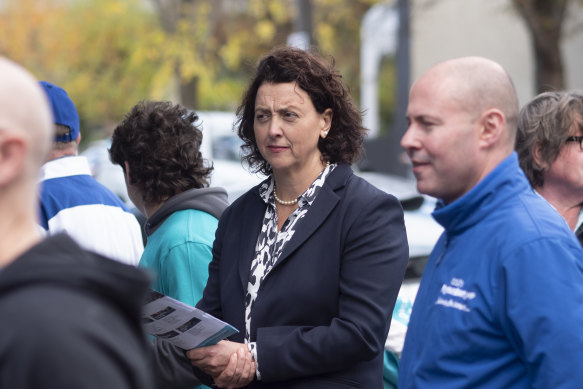
Ryan alongside rival Josh Frydenberg at an early voting centre in mid-May. Credit: Elke Meitzel
You can forgive Ryan for thinking politics seems like an extremely strange business. On a typical day in her previous life, she’d be assessing sick children, reading academic papers and running a team of 45 people. Now here she was, watching a blindfolded official draw balls out of a bingo barrel in a process that could determine her fate for the next three years.
Another bizarre experience was the early voting booth. This involved standing about a metre from Frydenberg for 11 days. She came to like her opponent less – because he called her a fake independent, rarely used her name and referred to her as “they” – yet felt for him. “It’s his life’s work. If I hadn’t won it would’ve been galling, disappointing and sad, but I could have gone back to my previous life. He was only going to be the leader of the opposition on [the] Monday [after the election] or unemployed. What an extraordinary position to be in. I could see how stressed he was.” [Frydenberg has since announced he is joining Goldman Sachs as a senior regional adviser for the Asia-Pacific.]
There were certainly some steep learning curves on the path from woman of science to political candidate. Her launch speech in December was, in Capling’s frank assessment, “pretty pedestrian”. Did Capling think they’d chosen the wrong candidate? “Not at all! I just thought we chose an academic used to deadpan, untheatrical and unperformative delivery. And, we all thought, ‘Look, she’s just spent a career trying to be calm and reassuring to little kids.’ ”
“If I hadn’t won it would’ve been galling, disappointing and sad, but I could have gone back to my previous life. He was only going to be the leader of the opposition or unemployed. What an extraordinary position to be in. I could see how stressed he was.”
Probably Ryan’s biggest blunder was made early on, when she failed to declare that she’d been a Labor Party member between 2007 and 2010. Asked by The Age if she had any political experience, she answered, “No, nothing. I am a complete cleanskin.” “That was a mistake,” she says now. She joined when Kevin Rudd won, promising climate change action, then left three years later when he failed to tackle the issue. “I never went to a meeting. I was never a political person. So I actually thought that I was a cleanskin.”
This was gold for Frydenberg, who said she had “sought to conceal” her political background from the media. Another little bit of gold, shared widely by Frydenberg, was when Ryan’s elderly mother-in-law told him that she would vote for him. The former treasurer, who declined to speak to Good Weekend for this article, criticised Ryan after she told talkback station 3AW that it was unreasonable to ask about the cost of her emissions reductions policies. He also thought Ryan had stepped outside her signed pledge to behave ethically and honestly when she called him the “treasurer for NSW” during their one town hall debate.
A senior Liberal, who declined to go on the record, said Ryan’s campaign, while having transparency and integrity as central planks, was part of a non-transparent, co-ordinated attack on Frydenberg that included anti-Liberal groups such as Smart Voting, which ran the “Chuck Them Out” bin-sticker campaign (Smart Voting is headed by two employees of the Holmes à Court-linked Smart Energy Council). “I don’t think I’ve ever heard of Smart Voting,” says Ryan in response. “I had no arrangements or help from any external organisations during the campaign except for Climate 200.”
When Ryan’s Active Hope mural, painted on a vacant pub wall, was removed by the building’s owners, Frydenberg accused Ryan’s campaign team of “disgracefully damaging private property”. (Climate 200’s founding director Damien Hodgkinson, a friend of the building’s owner, had wrongly assumed it was all right to go ahead.)
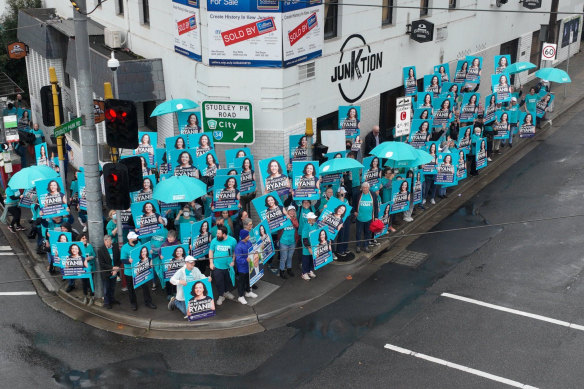
A flash protest at Kew Junction during the election campaign - along with a sole Frydenberg supporter.Credit: Aaron Smith
Despite Ryan’s missteps, Frydenberg was fighting significant anti-Liberal sentiment in Kooyong, notably the deep unpopularity of Scott Morrison. Yet Frydenberg wasn’t that popular, either: many were furious with him over his anti-lockdown stance during Melbourne’s extended COVID response. Shortly after the election, I met a Brunswick mum – a senior public servant and lawyer – who had signed up to Ryan’s campaign out of sheer rage over the former treasurer’s actions.
After the election, political commentators agreed that Ryan’s campaign beat Frydenberg’s on digital advertising, using data and social media, especially in reaching young people through TikTok. It also had, crucially, 2000 motivated volunteers who seemed to have a rollicking good time while knocking on 50,000 doors. But, says Capling, Ryan was her own secret weapon because “she is absolutely fabulous with people”.
Ryan says she conducted “a guerrilla movement” of joining several book clubs and asking members to introduce her to their contacts. But, it turned out, many people already knew her across the electorate: as an active school mum, at the Hawthorn pool where she swims three times a week, at her hockey club. She’d also treated many people’s children and had a seemingly endless posse of siblings and cousins.
Ryan walks me out to her front porch where we stand for a few minutes chatting. “Hello, beautiful boy!” she calls to Patrick, as the now 14-year-old arrives home, smartly besuited in his boys school uniform.
Earlier this month, I catch Ryan on the phone. She’s flat: the previous week brought several reality checks. Prime Minister Anthony Albanese cut the independents’ staff and, in response, she did a media interview in which she warned that a second wave of teals could go after Labor marginal MPs, such as Josh Burns in Macnamara and Michelle Ananda-Rajah in Higgins (she rang them to apologise). “It wasn’t factually untrue, but the context of what I said was absent and I came out sounding belligerent … To be honest, I felt quite foolish.”
The staffing issue shone a light on the limited negotiating power the teals will have in a lower house in which the government doesn’t need their votes. To get things done – for her electorate and for her wider agenda of action on climate change, integrity and gender equity – Ryan will need to be strategically savvy. This could prove difficult given, as Capling says, she’s by nature “not a political animal”. “She’s going to struggle for a while because she doesn’t want to feel like she’s playing political games. She wants to be authentic and honest.”
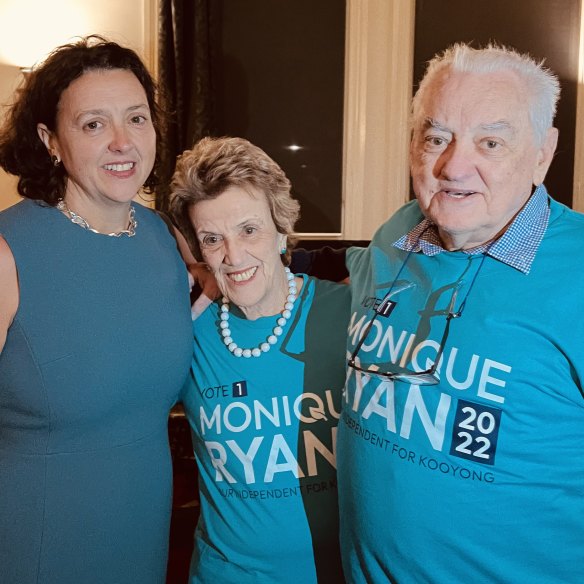
Ryan with her parents Marguerite and Maurice.Credit: Courtesy of Monique Ryan
Says long-term Canberra watcher, The Age and The Sydney Morning Herald associate editor Tony Wright: “Ryan and the other teal independents are about to understand that parliamentary politics is about power, which can be brutal.” But, he adds, Albanese is unlikely to underestimate the tide of women’s votes that brought the independents to parliament and that the treasurer-slaying Ryan “is clearly not to be taken lightly”.
There have been other reality checks, too: Ryan says the independents are sizing each other up, trying to figure out how things will work. “There are some pretty strong personalities. A lot of alpha females.” South Australian independent Rebekha Sharkie advised her that there were no friends in politics, only colleagues. “I’m not sure I can do that, I’m not that sort of person. But I understand what she is trying to say,” says Ryan.
She’s decided that health and the National Disability Insurance Scheme will be a policy focus. As a paediatric neurologist, she knew many families struggling to negotiate the NDIS. She’s trying to come to grips with how her absences in Canberra will affect her family, especially Patrick. She’s also grappling with the loss of anonymity in her electorate. “Completely self-inflicted of course,” she says. And the Gooms won’t let up. They accost her daily in the supermarket, and even in her bathers after swimming, to explain why she’s unqualified to be the MP for Kooyong.
Meanwhile, Ryan is now ensconced in Frydenberg’s old office. He left “a couple of highlighter pens and a ruler”, she says, but thankfully no prawns in the air-conditioning vent. “I’m still looking for the bottle of Veuve and the chocolates. I’m sure they’re here somewhere.”
To read more from Good Weekend magazine, visit our page at The Sydney Morning Herald, The Age and Brisbane Times.